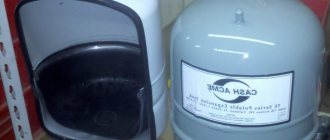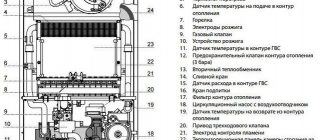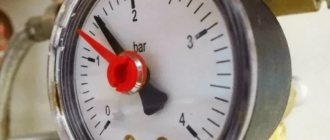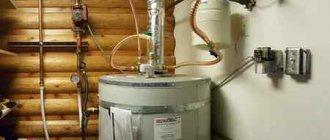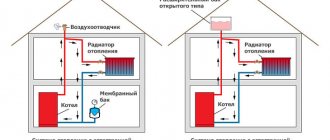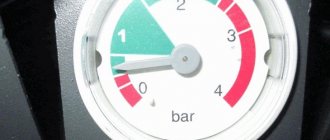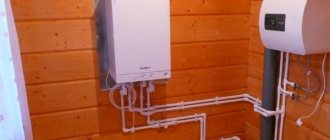Hi all! The author of the site Blogvp.ru, Vitaly, is in touch! I think you will agree that it is not a very fun experience to be left without heating and hot water on winter days. And this prospect came up several times in my house. I want to tell you how I struggled with this and what knowledge I acquired in this matter.
In my house, a gas double-circuit wall-mounted boiler ARISTON CLAS 24 FF is working to create comfort. Undoubtedly, the thing is extremely convenient; anyone who used, for example, geysers from the early nineties will understand.
But, as they say, nothing lasts forever, and therefore sooner or later, you have to deal with the refusal of technology to perform the intended work. In this article we will look at problems with pressure in the boiler, namely two types of this problem.
- When the pressure just keeps dropping.
- Cases when the pressure fluctuates, then up, then down.
- There are also cases when the pressure only increases, but more on that in another article, the link will be below.
PS - I did everything described using the example of my Ariston, but these manifestations will be common to almost any boiler. So, let's get down to business.
Leak in the heating system
The first thing you should check when the pressure is slowly decreasing is coolant leakage from pipes or leaky radiators. What is most often used as a coolant? That's right, water!
Believe me! It’s not easy to detect such a leak during the heating season, but the fact is that you won’t see a puddle on the floor, well, of course, unless it’s a serious leak, but in that case the pressure will drop instantly. Most often, the leak will be in the form of droplets and you will not see these droplets, since they quickly evaporate from heated pipes.
As a result, slowly but surely the pressure will drop. You add water over and over again and this continues to kill the radiators. Because the oxygen released from the incoming fresh water does not benefit them. In addition, most boiler models have protection and if there is insufficient pressure they simply turn off. It’s good if you are at home and respond to the problem, but what if there is no one at home for a long time???? This could turn out to be even more difficult.
How and where to look for a leak
You need to pay attention to radiator plugs, joints or soldering of pipes and fittings. You can often see traces of water leaks in the form of rusty or salt stains. But this depends on the composition of the water in your area.
It is not uncommon for modern radiators, aluminum or bimetallic, to also become unusable, sometimes in extremely inconspicuous places, between the ribs or from below, they begin to dig in due to metal corrosion. Not rust, of course, but various chemical processes also damage them. Radiators must be carefully inspected while searching for leaks.
It will be easier to detect various types of leaks if you turn off the heating for a while, let the radiators cool and add pressure to about 2.5 Bar. After this, you will be able to see drops or puddles on the floor. Carefully inspect the floors under the radiators, pipe connections, and soldering areas.
The boiler can also be the cause of the leak. For example, the primary heat exchanger itself or its connections are leaking. But as long as these are small droplets, you will not notice anything; they evaporate during operation of the boiler. As it begins to leak more actively, you will notice “drops” from the boiler.
Regardless of whether the burner is on or not, the leaking feed taps or emergency relief valve will be clearly visible.
So, the first reason for the pressure drop in the system is a coolant leak.
Leaking through threaded connections?
The boiler heating circuit is closed. The heated coolant flows from the heat exchanger tube into the supply pipe and then into the radiators. The coolant returns through the return pipeline, entering the heat exchanger again and then continuing to circulate in a circle.
The heating circuit pipes are connected to the supply and return pipelines using threaded (detachable) connections using connecting parts - connectors with union nuts, or otherwise American ones.
Threaded connection
Threaded connections are sealed with elastic, heat-resistant ring-shaped seals. When they wear out or are installed incorrectly, water leakage occurs. Poorly tightened nuts lead to the same consequences.
If you see water dripping at the threaded connection, you should first try tightening the nut. There is no need for excessive zeal here, since if the nut is tightened too much, it may break. If water leakage continues after tightening the nut, the seal must be replaced.
Turn off the gas and water supplies in advance and drain the water from the heat exchanger. Unscrew the union nut, replace the seals and install the nut in place.
Manufacturers of heating boilers seal detachable connections using gaskets made of rubber, silicone, paronite or other elastic materials. They are easy to use, durable and always available for sale. They often come complete with clamps. When choosing gaskets, take into account the thread size.
You can also use sanitary flax as a sealant. Regardless of the presence of leaks, seals are changed every time water communications are dismantled.
Expansion tank
Another reason is the expansion tank. This is a sealed container divided in half by a membrane, one half of the tank is filled with inert gas or just air, the other is filled with coolant (read water).
Expansion tank
It is designed to compensate for the pressure created during the expansion of the heated coolant.
When heated, the water in the system expands and fills its half of the tank, compressing the gas; when cooled, the coolant is again pushed into the heating system.
This is how temperature expansion in the heating system is compensated.
But sometimes the tank itself may malfunction.
Expansion tank malfunctions
For example, the tank body has lost its tightness and air is escaping from it. This does not happen often, and usually results in a fairly rapid decrease in pressure in the tank, from almost instantaneously to several days.
Also pay attention to the spool so that it does not poison the air either.
The spool (as in a car or bicycle) is located in the upper part of the tank; air is pumped through it, thereby creating the necessary pressure in the expander tank.
Another bad problem with the expander is the rupture of the membrane inside the tank, although it is not so delicate, and you need to “try” hard to break it. But if this happens, then identifying such a problem is not difficult.
In this case, the coolant enters from the heating system into that part of the tank that should be filled with air, and if pressing the spool needle throws water out of the tank, it means that water has penetrated where it should not be - the tank needs to be replaced.
But most often the pressure in the tank decreases very slowly, due to minor natural leaks. This decline in the tank occurs over many months or several years.
At the same time, the pressure in the expander chamber gradually decreases; naturally, it will also decrease in the readings of the boiler pressure gauge.
The behavior of the boiler very much depends on the level of this same pressure in the expander and can manifest itself in different ways. Under the next heading you will find a description of these problems.
Locations of water leaks
Leaks can occur along the entire water path. If a double-circuit gas boiler is leaking, the problem may be in the following components:
- heat exchanger;
- pipes;
- expansion tank;
- places of detachable connections.
The level of complexity of the upcoming repair largely depends on the location of the water leak.
The easiest way to eliminate leaks is at detachable connections. It is more difficult to repair a leaking pipeline inside the equipment. The most labor-intensive process is repairing or replacing the heat exchanger.
Connecting communications to a wall-mounted boiler
Leaks must be repaired as quickly as possible after they occur. Loss of coolant can lead to automatic shutdown of the boiler.
An attempt to compensate for the loss of coolant by periodically adding a new portion is fraught with accelerated wear of the boiler. Water is saturated with oxygen, which accelerates the corrosion of metal components, which reduces the life of heating equipment.
The pressure rises and falls - the boiler does not work stably
From all of the above, it is clear that air comes out from the part of the expansion tank in which it should be or does not have sufficient pressure. And here the pandemonium begins with changes in the operation of the boiler. All this can manifest itself in different ways and depends on the pressure in the air chamber of the Republic of Belarus.
For convenience, we will divide these manifestations into different stages.
FIRST STAGE - The pressure in the boiler drops slowly, about once a week you have to top up the boiler, but there are no obvious leaks in the expander, and there are no obvious leaks in the heating system itself.
SECOND STAGE - On the boiler pressure gauge, the pressure is constantly “walking” In heating mode it rises, perhaps even above 3 Bar, until the relief valve is activated; in hot water mode, on the contrary, it drops to values less than 1 bar and then the boiler may begin to shut down, the protection is triggered .(If it has a pressure sensor)
THIRD STAGE - If there is absolutely no air left in the tank, then the pressure on the pressure gauge drops to zero in a very short time, sometimes in a minute.
There is only one way out for all options! It is necessary to again create the necessary pressure in the expansion tank of your boiler, in its air part.
Pump on/off pressure
What happens if all the water leaves the tank and the pump does not turn on? In our tank, pumped up to 1 bar when empty, the minimum water pressure is 1 bar. That is, our water flows out, the pressure decreases and after the 1st bar it should simply drop to zero. Simply because there is no water. It's over. The motor starts running and the entire system experiences an unexpected load. Water is shot out of the pump, hits the pipes and is extinguished by the tank membrane, which takes the entire impact. This is not very comfortable and quite dangerous. It is much better if the pump turns on when there is still water in the tank! But not too much. In our case, the pump should turn on when the water pressure is greater than 1 bar. How much more? If it is much more, then we will reduce the amount of accumulated water and increase the frequency of pump activation (it will turn on more often and for less time), which is not good. Now we are beginning to understand why we were advised to pump the tank 2 tenths of a bar less than the pump activation pressure. In this case, when the pump is turned on, there will be a reasonable water level in the tank. Reasonable means justified by the manufacturer.
How to pump up a boiler expansion tank
Diagram of boiler taps Ariston Class 24
A Fitting for draining water into the central heating circuit (CH)
B Connection for draining water into the hot water supply circuit (DHW)
C Connection for gas supply
D Connection for cold water supply
E Connection for supplying water from the central heating circuit
S Safety valve outlet
T Drain tap
F Filling tap
How to properly pump air into the expansion tank
We follow the specified order
- Turn off the boiler from the network.
- We turn off all the taps to the boiler, supply, return, and cold water input.
- Open the drain fitting in the boiler. (T - in the diagram) and completely drain the water. (Here is an article about how to drain water from the boiler) The pressure in the boiler should be zero!
- We connect the pump with a pressure gauge to the RB through the spool - the drain fitting is open.
- The pump needs to pump air into the tank until water stops flowing from the drain fitting. At this stage, the main goal is to empty the tank of water.
- We release the pumped air by monitoring the pressure with a pump pressure gauge, and if necessary, pump it up. The pressure in the expander should be within 1.1-1.3 bar. (See the passport for your boiler - often indicated)
- Close the drain plug.
- We open all the taps to the boiler - everything that was closed.
- We feed the boiler through the make-up tap (F) to a pressure of approximately 1.2-1.5 bar
- Let's start the boiler.
To pump air into the expansion tank, you can use any pump and pressure gauge. There is a car nipple there. I used an auto compressor. True, for this I had to drag the battery home. With an electric compressor, be careful to turn it off in time and not over-pump.
Before starting the boiler, it will not be superfluous to expel any air that has entered the system.
In Ariston class 24, to do this, press and hold for about 5 seconds. ESK button. The boiler will go into purge mode for 6 minutes, exit this mode on its own, or you can force it by pressing ESK again.
If you need boiler repair or maintenance, call Profteplo
We work in Kaluga and the region, diagnosing, servicing and repairing systems of any complexity. We carry out both simple tasks of pumping air into an expansion tank, and complex complex repairs of modern systems. We provide a guarantee for all types of work.
If you need advice or want to use the service, just call the number or leave a request directly on the website. The master will arrive on the day of your call and will perform all the necessary types of work.
Source
Reasons: why the antifreeze level rises
Every driver who has encountered such an unpleasant phenomenon has a question about why the level of antifreeze can increase in such a way. By itself, it does not change the volume, since the coolant practically does not expand from high temperature. But its impaired circulation can affect the amount of coolant remaining in the expansion tank. Various factors can lead to this. The most common reasons are:
Reducing the free space under the cylinder head. The main part of the antifreeze in the cooling system is located in the cylinder head. The cylinder head itself heats up under the influence of high temperature, and the metal parts increase in volume. The space available for coolant is reduced, causing the fluid to rise higher. But even with maximum heating of the cooling jacket, it cannot increase by more than 10%, which will still prevent it from exceeding the norm and overflowing.
Why does the antifreeze level in the expansion tank rise?
While the car is running, the engine gets hot, and this is normal. To ensure that its temperature does not become critical and the car does not overheat, the cooling system needs to work. For this purpose, coolant is used, the circulation of which ensures proper operation of the engine. Therefore, its level in the expansion tank is one of the most important parameters that allows you to calculate a breakdown in time. Therefore, many drivers have a question about why the antifreeze level is rising and what to do about it.
Content
You may also be interested
Why antifreeze curdled: reasons and what to do
In some cases, a motorist may find foamed and heterogeneous rust-colored something under the cover. In this case, experienced drivers state: “The antifreeze has curdled.” Why does this happen and how to deal with it? This is exactly what we will discuss with experts in an article on our website.
How does antifreeze get into the engine?
Among the malfunctions that can happen to a car, one of the most common is antifreeze getting into the internal combustion engine. If oil gets into the antifreeze, you should also immediately diagnose and eliminate the cause of the breakdown. This will avoid major repairs to the machine and minimize damage.
Heating devices
In systems with natural circulation, you can use only radiators, as well as thick pipes as radiators (they have less hydraulic resistance).
But, alas, you cannot use convectors - natural circulation simply will not flow through them.
To summarize the above, an open system is a thing of the past. Slow heating, high inertia of the system, a large amount of soluble air, bulky pipes, and low efficiency make it unattractive for modern heating systems. So it is used in extreme cases - for example, in areas where electricity is often cut off.
The most popular now are closed systems with forced circulation of coolant, two-pipe or collector-beam.
Today no one will be surprised by an autonomous water supply system. Such designs are very convenient and practical, but their operation often requires devices that a person who uses only a centralized water supply may simply not know about. For example, an autonomous water supply system will operate uninterruptedly for a long time only if it includes an expansion tank for water supply. Modern industry produces many different models of such devices. To choose the best option for yourself, you need to navigate the types of equipment and have a good understanding of the principle of its operation.
Preventing problems
In order to prevent breakdowns, you need to properly operate the cooling system. The right preventive measures can save your car from repairs. If you want to prevent the antifreeze level from rising, you need to:
- Use only good, proven coolant, preferably from the same company as the car itself.
- Do not mix several coolants that differ in class and type.
- Monitor the level of antifreeze in the tank and measure it from time to time.
- When changing the fluid, rinse the reservoir with clean water.
If you have already noticed an increase in the coolant level, it is best to immediately contact a car service for a more accurate diagnosis of problems and repairs. This will help avoid accidents and more serious damage.
